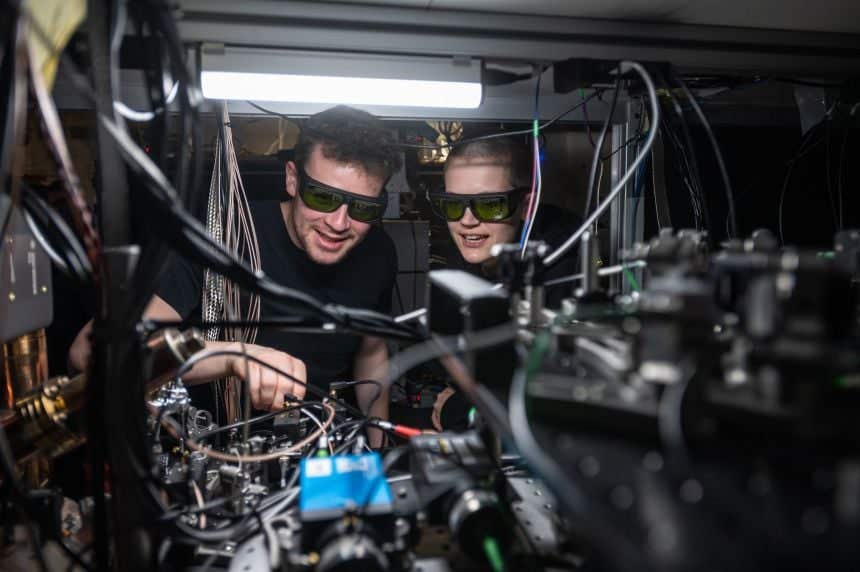Oxford physicists achieve teleportation between two quantum supercomputers
Oxford physicists link two quantum computers with light, paving the way for scalable distributed quantum computing.

Dougal Main and Beth Nichol working on the distributed quantum computer. (CREDIT: John Cairns / Oxford University)
In a laboratory at Oxford University, scientists have achieved something that once seemed science fiction: they made two separate quantum computers work together as one. Instead of being connected by wires, these machines shared information through light, effectively forming a single, unified quantum computer.
The experiment marks the first time researchers have run a full quantum algorithm across two distant modules using a process called quantum gate teleportation.
This achievement could change the way we think about computing. Rather than building massive quantum processors packed with millions of fragile qubits, scientists can now link smaller, modular quantum units that talk to each other through photons—particles of light. It’s a strategy that makes the dream of scalable quantum computers more realistic than ever.
Why Linking Quantum Computers Matters
Quantum computers are unlike anything you’ve used before. Instead of processing data in bits that are either a one or a zero, quantum computers use qubits—particles that can exist in multiple states at once. This strange property lets quantum systems perform complex calculations far faster than any classical computer. They could help design new drugs, break encryption codes, and simulate physical systems impossible to model today.
But there’s a problem: controlling large numbers of qubits inside a single machine is incredibly hard. The more qubits you pack together, the more noise, interference, and instability you get. Dougal Main, a researcher at Oxford Physics, put it simply: “By interconnecting the modules using photonic links, the system gains flexibility, allowing modules to be upgraded or swapped without disrupting the entire architecture.”
Distributed quantum computing, or DQC, tackles that problem by splitting the job among several smaller processors. Each module handles part of a task, while photons carry quantum information between them. In theory, there’s no limit to how many modules you can connect—creating the potential for a network of quantum computers acting in unison.
Inside the Experiment
In Oxford’s setup, two quantum modules—nicknamed Alice and Bob—sat about two meters apart. Each module contained two ions held in place by electric fields inside a vacuum chamber. One ion, made of strontium (^88Sr⁺), acted as the “network” qubit that sends and receives photons. The other, a calcium ion (^43Ca⁺), served as the “circuit” qubit that stores and processes quantum data.
The two modules became linked when each emitted a photon that traveled to a central optical device called a Bell-state analyzer. This setup entangled the two photons—and, through them, the two network qubits—creating a quantum bridge between the modules. Once entangled, a quantum operation known as a controlled-Z (CZ) gate was teleported between the two circuit qubits.
Unlike traditional data transfer, nothing physically moved between Alice and Bob. Instead, quantum information was shared instantly through entanglement, while classical communication handled the coordination. The fidelity—the measure of how accurately the gate worked—was an impressive 86.2%. Even more remarkable, the entangled connection itself held a fidelity of nearly 97%, showing the process is highly reliable.
Building on Quantum Gate Teleportation
Running a single teleported gate is one thing, but real computation requires sequences of them. The researchers used multiple rounds of teleportation to perform more complex quantum operations, including iSWAP and SWAP circuits. These let the qubits exchange states—an essential feature of larger-scale algorithms.
To prove their approach could handle full computations, the team ran Grover’s search algorithm, a classic test in quantum computing that finds a target item from an unsorted list much faster than conventional computers. After hundreds of runs, the linked modules found the correct result about 71% of the time—imperfect, but groundbreaking. It was the first time a distributed quantum algorithm with multiple teleported gates had been executed on physically separated modules.
Where the Errors Creep In
Despite the success, the experiment wasn’t flawless. The researchers mapped out several sources of error, including minor mistakes in local gate operations, small imperfections in photon collection, and gradual calibration drifts. Measurements taken mid-experiment also introduced inconsistencies when signals were sent between modules.
Still, the performance exceeded expectations. Local operations maintained over 98% fidelity, and researchers believe they can boost that number with better control systems and calibration methods. As Professor David Lucas, the study’s principal investigator, noted, “Our experiment demonstrates that network-distributed quantum information processing is feasible with current technology. Scaling up quantum computers remains a formidable technical challenge, but this shows the path forward.”
Toward a Quantum Internet
The Oxford team’s results suggest something even more exciting than a bigger quantum computer: the foundation for a quantum internet. In such a network, distant quantum processors could exchange information securely and instantaneously using entanglement. Unlike the current internet, which depends on classical signals that can be intercepted or corrupted, quantum data transfers would be inherently tamper-proof.
The experiment’s architecture could also support hybrid systems that blend different types of qubits, such as trapped ions, neutral atoms, or diamond-based quantum bits. Because the method relies on photons for communication, it’s flexible enough to bridge many quantum technologies. With further refinements, it could even link quantum computers across cities—or continents—through optical fibers or satellite channels.
A Glimpse of What’s Coming
For now, distributed quantum computing still faces challenges. Engineers must reduce noise, improve synchronization, and increase the speed of entanglement generation. But each step forward brings the technology closer to practical use. As Main explained, “By carefully tailoring interactions between distant systems, we can perform logical quantum gates between qubits housed in separate quantum computers. This breakthrough enables us to effectively wire together distinct processors into a single machine.”
What makes this so transformative is scalability. Instead of building one enormous quantum processor, scientists can connect smaller, specialized units—a more flexible and cost-effective approach. It’s similar to how classical supercomputers are made up of smaller linked computers that share processing power.
Practical Implications of the Research
The implications stretch far beyond the lab. Distributed quantum computing could revolutionize secure communication, data encryption, and artificial intelligence. Quantum networks would enable ultra-secure communication systems resistant to hacking. They could allow scientists to simulate complex molecules to speed up drug discovery or model large-scale systems like climate dynamics and financial markets.
In time, modular networks of quantum processors could form the backbone of a global quantum internet—one that’s faster, more secure, and more powerful than anything available today.
The Oxford breakthrough doesn’t just prove what’s possible; it shows how humanity might soon share and compute information at the speed of light.
Research findings are available online in the journal Nature.
Related Stories
- For the first time ever, researchers demonstrate quantum teleportation over fiber-optic cables
- Quantum teleportation is unlocking a new age of innovation
- Quantum Teleportation: The Next Frontier in Technology and Science
Like these kind of feel good stories? Get The Brighter Side of News' newsletter.
Shy Cohen
Science & Technology Writer



